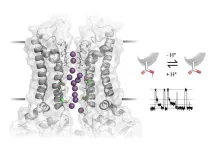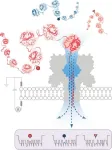(Press-News.org) INDIANAPOLIS – Periodontal disease is a growing public health issue in the United States as the nation’s population ages, yet it’s underdiagnosed and undertreated. According to the U.S. Centers for Disease Control and Prevention (CDC), 47 percent of adults aged 30 years and older and 79 percent of adults 65 years and older have some form of periodontal disease.
Researchers from Regenstrief Institute and Indiana University School of Dentistry have developed computer algorithms to track periodontal disease change, which could help dentists and periodontists follow disease progression. They also have developed tools to enable the use of electronic dental record data to automate diagnosis of the disease.
In the early stage of periodontal disease – gingivitis – gums are swollen, red and may bleed. In its more serious form, called periodontitis, the gums can pull away from the tooth, bone can be lost, and teeth may loosen or even fall out. Retention of natural teeth is important for good nutrition and other factors related to maintaining good health.
“Gum disease, which is typically underdiagnosed, is reversible if caught at an early stage before it has affected underlying structures and adversely impacted tooth support. Enabling dentists to track the disease using both the information in clinical notes and the periodontal charting data contained in a patient’s electronic dental record can enable diagnosis and hope,” said Thankam Thyvalikakath, DMD, MDS, PhD, who leads the Regenstrief Institute-IU School of Dentistry Dental Informatics Program. Adding that “we are here to develop and establish a culture of documenting and diagnosing cases in a structured manner as is done in medicine,” she notes that approximately 90 percent of dental practices in the U.S. use electronic dental records.
“I think the advantage of our approaches is that, using routinely collected data, we can automate and monitor gum disease treatments and changes that are visible only clinically, so we can catch gum disease at an early, potentially reversible, stage. This contrasts with other approaches that leverage only radiographs, which only show advanced gum disease.”
Factors increasing risk of periodontal disease include tobacco use, diabetes, poor oral hygiene, stress, defective dental fillings, and bridges as well as medications that cause dry mouth.
“There is a bidirectional relationship between certain risk factors and gum disease,” said Dr. Thyvalikakath. “For example, having diabetes increases risk of periodontal disease and having periodontal disease negatively affects the course of diabetes. A similar relationship exists between cardiovascular disease and periodontal disease. Recognizing, monitoring, and treating gum disease is an important part of overall patient health.”
“Developing Automated Computer Algorithms to Track Periodontal Disease Change from Longitudinal Electronic Dental Records” is published in a special issue, “Advances in Biomedical and Dental Diagnostics Using Artificial Intelligence,” of the peer-reviewed, open access journal Diagnostics.
Authors and their affiliations
Jay S. Patel1,2,3, Krishna Kumar1, Ahad Zai1,4, Daniel Shin1, Lisa Willis1, and Thankam P. Thyvalikakath1,4.
1 Dental Informatics Program, Department of Cariology Operative Dentistry and Dental Public Health, Indiana University School of Dentistry, Indianapolis, IN 46202, USA.
2 Health Informatics, Department of Health Services Administrations and Policy, Temple University College of Public Health, Philadelphia, PA 19122, USA.
3 Department of Oral Health Sciences, Temple University Kornberg School of Dentistry, Philadelphia, PA 19140, USA.
4 Dental Informatics Program, Center for Biomedical Informatics, Regenstrief Institute, Indianapolis, IN 46202, USA.
2023 MedInfo presentation
“Feasibility of utilizing electronic dental record data and periodontitis case definition to automate diagnosis” was presented by Dr.Thyvalikakath at MedInfo 2023: the 19th World Congress on Medical and Health Informatics, held in Sydney, Australia. The paper is scheduled to be published in the meeting proceedings.
Authors and their affiliations
Jay Patela,b, Daniel Shinc, Lisa Willisa, Ahad Zaia, and Thankam Thyvalikakatha,d.
aDental Informatics Division; Department of Cariology, Operative Dentistry, and Dental Public Health; Indiana University School of Dentistry; Indiana University Purdue University Indianapolis, Indianapolis, IN, USA
bDepartment of Health Services Administration and Policy, College of Public Health Temple University, Philadelphia, PA, USA
cDepartment of Periodontology, Indiana University School of Dentistry; Indiana University Purdue University Indianapolis.
dCenter for Biomedical Informatics, Regenstrief Institute, Inc., Indianapolis, Indiana
Thankam Thyvalikakath, DMD, MDS, PhD
In addition to her role as a research scientist with the Clem McDonald Center for Biomedical Informatics at Regenstrief Institute and director of the Regenstrief and IU School of Dentistry Dental Informatics Program, Thankam Thyvalikakath, DMD, MDS, PhD, is a professor and the associate dean of dental informatics and digital health at IU School of Dentistry and an adjunct professor in the IUPUI Luddy School of Informatics, Computing and Engineering.
About the Regenstrief-IU School of Dentistry Dental Informatics Program
Established in 2019, the Regenstrief Institute-IU School of Dentistry Dental Informatics Program is one of the first in the U.S. The program uses both electronic dental and medical record data for clinical research to develop interoperable databases and advance the knowledge of oral health problems that cause, co-occur with, or result from medical conditions. The goal is to implement findings into dental clinics and other points of care.
About Regenstrief Institute
Founded in 1969 in Indianapolis, the Regenstrief Institute is a local, national and global leader dedicated to a world where better information empowers people to end disease and realize true health. A key research partner to Indiana University, Regenstrief and its research scientists are responsible for a growing number of major healthcare innovations and studies. Examples range from the development of global health information technology standards that enable the use and interoperability of electronic health records to improving patient-physician communications, to creating models of care that inform practice and improve the lives of patients around the globe.
Sam Regenstrief, a nationally successful entrepreneur from Connersville, Indiana, founded the institute with the goal of making healthcare more efficient and accessible for everyone. His vision continues to guide the institute’s research mission.
About Indiana University School of Dentistry
The only dental school in the Hoosier state, Indiana University School of Dentistry (IUSD) offers an extraordinary learning environment in which teaching, research and community service come together in the best way possible for the preparation of tomorrow’s dental professionals. About 80 percent of the dentists practicing in the state of Indiana are alumni of the school.
Founded in 1879 in Indianapolis, IUSD is located on the health sciences campus of IUPUI, one of the outstanding urban universities in the United States with a recognized commitment to community engagement. IUSD capitalizes on the campus’s central location in the state and its position in the research corridor that links IUPUI, Purdue University West Lafayette, and Indiana University Bloomington. IUSD faculty conduct world-class interdisciplinary research in collaboration with the other IU health science schools and the Purdue Schools of Engineering and Technology and Science.
END
Tracking periodontal disease to improve diagnosis and treatment
Newly developed automated methodologies use routinely collected data
2023-08-01
ELSE PRESS RELEASES FROM THIS DATE:
Frank J. Malina Astronautics Medal awarded to Klaus Schilling
2023-08-01
The International Astronautical Federation (IAF) selected Würzburg space expert Professor Klaus Schilling for the Frank J. Malina Astronautics Medal 2023. This medal is a top award in the space sector for innovative research and for commitment to education.
According to a statement by the IAF, the medal is awarded each year to a personality who has provided outstanding services to space education and research. This applies to Professor Schilling without reservation: "He has provided numerous students with practical experience in satellite construction and has been involved in a wide ...
New study sheds light on the gating mechanism of ion channels
2023-08-01
Ion channels play a crucial role in many cellular processes, including neuronal communication, muscle contraction or cell proliferation. Most multi subunit ion channels exist in two functional states, either closed or open. During gating, one should expect that all subunits undergo conformational changes. The absence of intermediate conduction levels is surprising and asks for an explanation. A team of researchers from the University of Vienna and the Washington University in St. Louis created a smart model system to answer this important question. The study is currently published in Nature ...
Fossil unveils leaf eating among earliest birds
2023-08-01
A new type of analysis of a spectacular 120-million-year-old fossil skeleton of the extinct early bird Jeholornis from northeastern China has revealed the oldest evidence for birds eating leaves, marking the earliest known evolution of arboreal plant-eating among birds.
The pheasant-sized Jeholornis, a member of the second most primitive lineage of known birds, has teeth and a long bony tail like its predatory, feathered dinosaur relatives. However, microscopic analysis of the fossilized residues in the stomach of this juvenile, arboreal (tree-living) bird demonstrates that Jeholornis was not a predator. It had eaten tree leaves from a group ...
Nanopore technology achieves breakthrough in protein variant detection
2023-08-01
Scientists have developed a breakthrough method to detect structural variations on proteins based on nanopore technologies.
Protein chains are fed through an engineered nanopore, with subtle variations in structure detected through the modulation of tiny electrical currents.
The method could transform our understanding of how protein variants are associated with diseases, and allow point-of-care diagnostics.
A team of scientists led by the University of Oxford have achieved a significant breakthrough in detecting modifications on protein structures. The method, published in Nature Nanotechnology, employs innovative nanopore technology to identify structural ...
Google & ChatGPT have mixed results in medical informatiom queries
2023-08-01
When you need accurate information about a serious illness, should you go to Google or ChatGPT?
An interdisciplinary study led by University of California, Riverside, computer scientists found that both internet information gathering services have strengths and weaknesses for people seeking information about Alzheimer's disease and other forms of dementia. The team included clinical scientists from the University of Alabama and Florida International University.
Google provides the most current information, but query results are skewed by service and product providers seeking customers, the researchers found. ChatGPT, meanwhile, ...
A novel laser slicing technique for diamond semiconductors
2023-08-01
Silicon-based materials are currently the undisputed leaders in the field of semiconductors. Even so, scientists around the world are actively trying to find superior alternatives for next-generation electronics and high-power systems. Interestingly, diamonds are among the most promising materials for applications such as fast telecommunications and power conversion in electric vehicles and power plants.
Despite their attractive properties for the semiconductor industry, the applications of diamonds are limited due to the lack of techniques to slice them into thin wafers efficiently. As a result, diamond wafers must be synthesized one by one, making fabrication ...
California’s winter waves may be increasing under climate change
2023-08-01
A new study from UC San Diego Scripps Institution of Oceanography researcher emeritus Peter Bromirski uses nearly a century of data to show that the average heights of winter waves along the California coast have increased as climate change has heated up the planet.
The study, published today in the Journal of Geophysical Research - Oceans, achieved its extraordinarily long time series by using seismic records dating back to 1931 to infer wave height, a unique but accepted method first developed by Bromirski in 1999. The results, made more robust by their ...
DNA decodes the dining preferences of the shell-shucking whitespotted eagle ray
2023-08-01
With mighty jaws and plate-like teeth, the whitespotted eagle ray (Aetobatus narinari) can pretty much crunch on anything. In fact, hard clam farmers in Florida’s Indian River Lagoon have considered this species a threat to their production efforts and profit margin. This assumption, however, is mostly anecdotal.
Despite their protected status in Florida and designation as globally “endangered,” there is limited information in the United States available on critical components of the life history of the whitespotted eagle ray, such as their diet. Prior observations have described a location-specific yet variable diet consisting of hard ...
GI symptoms persist in older female colorectal cancer survivors
2023-08-01
COLUMBUS, Ohio – More than 4 out of 5 older women survivors of colorectal cancer may be experiencing a range of gastrointestinal symptoms many years after being diagnosed and treated, a new study suggests.
Using data from the Women’s Health Initiative, researchers found that 81% of colorectal cancer survivors reported persistent GI symptoms, with abdominal bloating and gas topping the list as the most common and severe problem. The average time since diagnosis was eight years for all participants whose data was used in the study.
The analysis also showed that severe GI symptoms were linked to poor quality of life, ...
CHLA researcher to lead first-ever international liquid biopsy retinoblastoma study
2023-08-01
Just a handful of years ago, retinoblastoma had the medical field stumped. This pediatric eye cancer cannot be directly biopsied, which means clinicians must diagnose the disease by visual examination and imaging. Recently, a researcher at Children’s Hospital Los Angeles developed a new way to diagnose retinoblastoma by sampling the fluid at the front of the eye. These liquid biopsies also offer genetic and chromosomal information, which gives a more complete picture of each child’s disease. Now CHLA will lead an international liquid biopsy retinoblastoma study, the first of its kind.
A New Line of Research
Jesse Berry, MD, is the Director of Ocular Oncology ...
LAST 30 PRESS RELEASES:
A decline in churchgoing linked to more deaths of despair
TAMEST announces Maralice Conacci-Sorrell, Ph.D., UT Southwestern Medical Center, as 2026 Mary Beth Maddox Award & Lectureship Recipient
Global study to evaluate whether dengue outbreaks can be anticipated earlier
Chonnam National University researchers propose innovative voltage-loop control for power factor correction
Accelerating next-generation drug discovery with click-based construction of PROTACs
Detecting the hidden magnetism of altermagnets
$7M gift supports health research, engineering and athletics at UT San Antonio
NU-9 halts Alzheimer’s disease in animal model before symptoms begin
Hospitals acquired by real estate investment trusts associated with greater risk of bankruptcy, closure
City of Hope scientists study rare disorder to uncover mechanism and hormone regulation underlying fatty liver disease and sweet aversion
Your genes may influence gut microbiome of others, rat study shows
‘Personality test’ shows how AI chatbots mimic human traits – and how they can be manipulated
Global food systems driving twin crises of obesity and global heating
Osaka Medical and Pharmaceutical University researchers capture real-time molecular movies of enzyme catalysis
Could your genes influence the gut microbiome of others?
Clues to Alzheimer’s disease may be hiding in our ‘junk’ DNA
Study reveals that the body uses different sensors to detect cold in the skin and in internal organs
iPS cells from dish to freezer and back
Deep neural networks enable accurate pricing of American options under stochastic volatility
Collective risk resonance in Chinese stock sectors uncovered through higher-order network analysis
Does CPU impact systemic risk contributions of Chinese sectors? Evidence from mixed frequency methods with asymmetric tail long memory
General intelligence framework to predict virus adaptation based on a genome language model
Antibiotic resistance is ancient, ecological, and deeply connected to human activity, new review shows
Vapes, pouches, heated tobacco, shisha, cigarettes: nicotine in all forms is toxic to the heart and blood vessels
From powder to planet: University of Modena engineers forge a low-carbon future for advanced metal manufacturing
Super strain-resistant superconductors
Pre-school health programme does not improve children’s diet or physical activity, prompting call for policy changes, study finds
Autumn clock change linked to reduction in certain health conditions
AI images of doctors can exaggerate and reinforce existing stereotypes
Where medicine meets melody – how lullabies help babies and parents in intensive care
[Press-News.org] Tracking periodontal disease to improve diagnosis and treatmentNewly developed automated methodologies use routinely collected data






